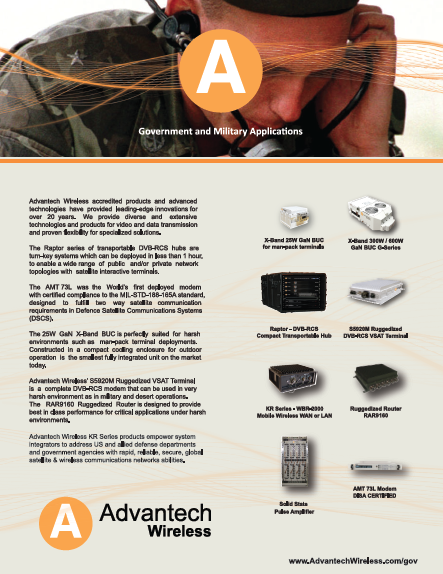U.S.A.F.—1st Space Ops To Control GSSAP
The 1st Space Operations Squadron at Schriever AFB, Colorado, will assume command and control of the Geosynchronous Space Situational Awareness Program (GSSAP) this summer.
The satellites are a space-based capability that will operate in the near-geosynchronous orbit regime supporting U.S. Strategic Command space surveillance operations as a dedicated Space Surveillance Network sensor.
Gen. William L. Shelton, commander of Air Force Space Command, directed the 1st SOPS to add command and control of GSSAP to the portfolio of Space Situational Awareness systems they control. Those include the Space Based Space Surveillance satellite and the Advanced Technology Risk Reduction (ATRR) satellite.
The first two GSSAP satellites are scheduled to launch July 23, aboard a United Launch Alliance Delta IV booster from Cape Canaveral Air Force Station, Florida.
The 1st SOPS will assume operation of GSSAP following launch and initial check-out. The satellites will communicate information through worldwide Air Force Satellite Control Network ground stations to the 1st SOPS where satellite operators will oversee day-to-day operation of the satellites.
“This marks a great milestone for the 1st SOPS and AFSPC,” said Shelton. “With the alignment of the GSSAP mission to the 1st SOPS, we will achieve new synergies within the Space Situational Awareness mission area. Operating the new GSSAP mission alongside our other space-based SSA systems will allow personnel to collaborate across multiple, highly capable SSA systems within the same squadron.”
GSSAP satellites are designed to support Joint Functional Component Command for Space tasking to collect space situational awareness data which will allow for more accurate tracking and characterization of man-made orbiting objects.
GSSAP will operate in a near-geosynchronous orbit where it will have a clear, unobstructed and distinct vantage point for viewing resident space objects in the geosynchronous orbit regime without the disruption of weather or atmosphere that can limit ground-based systems.
* * * * * * * * *
DOD—Military Space Policy + The Challenges...
If potential adversaries are to challenge the United States, they must do so in the space domain, the Defense Department’s top space policy official has told Congress

Douglas L. Loverro, Deputy Assistant Secretary of Defense for Space Policy.
Douglas L. Loverro, deputy assistant secretary of defense for space policy, joined by Air Force Gen. William L. Shelton, commander of Air Force Space Command, testified before the Senate Armed Services Committee’s Strategic Forces Subcommittee on the department’s space program posture.
“Over the last 15 years, other nations have watched us closely,” he said. “They have recognized that if they are to challenge the United States, they must challenge us in space. And they are endeavoring to do so. The United States has successfully addressed such challenges before in air, sea and land domains, and now we must, likewise, respond in space.”
This must be done against the backdrop of decreasing budgets that challenges both the ability and speed with which the United States can act, he said, adding that this in no way diminishes the importance of successfully sustaining the crucial advantages that space provides.
“Our strategic approach for these issues remains consistent with what we outlined in the 2011 National Security Space Strategy and reaffirmed in DOD space policy in 2012,” Loverro said.
While Loverro acknowledged he is concerned about the contested nature of space, he said it remains important to national defense.
“Space remains, and will continue to remain, vital to our national security,” he added. “It underpins DOD capabilities worldwide at every level of engagement, from humanitarian assistance to the highest levels of combat. It enables U.S. operations to be executed with precision on a global basis with reduced resources, fewer deployed troops, fewer casualties and decreased collateral damage.”
Space empowers U.S. forces and allies to win faster and to bring more warfighters home safety, he said.
“It’s a key to U.S. power projection,” Loverro said, “providing a strong deterrent to our potential adversaries and a source of confidence to our allies.”
But the evolving strategic environment increasingly challenges U.S. space advantages, he said, because space no longer is the sole province of world powers—it is a frontier that is now open to all.
Space has become more competitive, congested and contested, Loverro said, referring to that condition as the “so-called three C’s.” As an American, he said, he welcomes the competitive aspect of today’s space environment.
“I’m highly confident that, with the right policies, the U.S. is well positioned to remain ahead in that environment,” Loverro said.
The changes Congress authorized two years ago on export control reform, Loverro said, coupled with changes NASA and DOD have embraced on commercial launch, are just two of the many reasons he isn’t concerned with the competitive nature of space.
“On the second ‘C,’ congestion, I am not quite so welcoming,” he said. “But I am optimistic. Congestion and debris in space is a real issue, and it threatens to put our use of space at risk.”
Loverro praised efforts such as the Air Force’s Space Fence program that are aimed at reducing this risk, as well as the work DOD, the State Department and the United Nations are doing internationally to set “rules of the road” for outer space.
The space situational awareness sharing that U.S. Strategic Command is leading, he said, also is aimed at bringing a similar focus on this issue to the community of space-faring nations.
Shelton voiced similar concerns regarding the contested margin of U.S. advantage in space.
“Our nation’s advantage in space is no longer a given,” he said. “The ever-evolving space environment is increasingly contested, as potential adversary capabilities grow in both number and sophistication.”
The general said providing budget stability and flexibility in the dynamic, strategic space environment is necessary to maintain and bolster the viability of the nation’s space capabilities.
“Given this new normal for space, I believe that we are at a strategic crossroads,” he said. It is a reality that requires us to address how we protect our space systems, challenge traditional acquisition practices and consider alternative architectures that are more resilient and more affordable.”
Shelton thanked the committee for supporting the military space policy program. “I look forward to working with the Congress to keep you abreast of our efforts to provide resilient, capable and affordable space capabilities for the joint force and for the nation,” he added.
Story by Army Sgt. 1st Class Tyrone C. Marshall Jr., American Forces Press Service
* * * * * * * * *
Canadian Army—Anti-Jamming Antenna Field Tested
For Canadian soldiers in the field, accurate positioning and timing information is critical to operations.
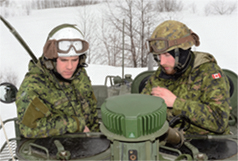
A few years ago Defence Research and Development Canada (DRDC) identified a requirement to develop an innovative, low cost solution to protect land vehicles in Canadian Army like the Light Armoured Vehicle (LAV) III from GPS jamming.
The device has evolved from a prototype to a product undergoing testing through two separate contracts.
Under the first contract, an industrial research contract with DRDC, Calgary-based NovAtel developed the GPS Anti-Jamming Technology, or GAJT, prototype.
NovAtel continued to develop the technology and recently released a commercially available product, the GAJT-700ML.
“The Canadian Army requires accurate, secure and reliable access to Global Positioning Systems to conduct operations throughout the full spectrum of conflict in all potential theatres of operation,” said Colonel Andrew Jayne, Director Land Requirements.
“With the ever-increasing demands on the electromagnetic spectrum and threat of harmful interference, technologies which contribute to the assurance of position and timing information are a critical enabler of Army and Canadian Armed Forces operations in today and tomorrow’s operating environment.”
“GAJT is a great example of a technology with its roots in research that has evolved through years of work into a product that the CAF can use to their advantage,” said Mike Vinnins, of DRDC’s Navigation Warfare Group.
The Canadian Army’s Directorate of Land Requirements (DLR), the Quality Engineering Test Establishment (QETE) and the Canadian Army Trials and Evaluation Unit (CATEU) conducted field testing of GAJT from March 3 to 6, 2014, on a LAV III Observation Post Vehicle (OPV) at Canadian Forces Base Garrison Petawawa.
Public Works and Government Services Canada procured GAJT for testing through its Build in Canada Innovation Program (BCIP).
Defence Scientists from DRDC’s Navigation Warfare group provided key scientific and technical support at the field test.
“We provided localized low power jamming of the LAV III OPV to test the effectiveness of the GAJT at preventing interference from GPS jamming,” said Scott McLelland, a DRDC Defence Scientist who attended the test.
DRDC’s data logging equipment was used to record the performance of the LAV III’s navigation systems during the trial.
“The data logger integrates into the LAV III’s sophisticated electronics to capture the data from its navigation systems,” explained McLelland. “It allows the personnel evaluating the test data to visualize the impact of GAJT in jammed and non-jammed environments on the LAV III’s recorded position as it traveled along a predefined route.”
* * * * * * * * *
Laser Light Communications + DISA—R&D Agreement Now In Place
Laser Light™ Communications, LLC (LLC) now has a Cooperative Research and Development Agreement (CRADA) with the Defense Information Systems Agency (DISA) relating to LLC’s Global Hybrid Satellite-Terrestrial All Optical Network™ technology.
LLC and DISA have entered into the agreement to establish a cooperative research and development effort to assess the potential use of an all-optical, laser-based Medium Earth Orbit (MEO) communication satellite solution that could be seamlessly integrated into the global terrestrial communications network. An all-optical satellite communication (SATCOM) system potentially offers numerous advantages over conventional SATCOM systems: 1. It can potentially provide an enormous increase in data transfer rates; 2. It is a more secure system; 3. It will eliminate the issue of spectrum allocation; 4. It will mitigate the challenge of mutual interference as satellite spacing will no longer be an issue.
The agreement will allow DISA to evaluate the underlying technology and evaluate the long-range potential of what may be achievable with the all-optical SATCOM system.
“We are pleased to be a collaborator with DISA in this important effort,” said Robert H. Brumley, Senior Managing Director of LLC.
DISA is a combat support agency of the Department of Defense (DoD).
* * * * * * * * *
Boeing + SCT—Make Ready For Morelos-3
The Mexican Ministry of Communications and Transportation (SCT) and Boeing are a step closer to enhancing Mexico’s mobile communications capabilities for government applications with the completion of the second Mexsat 702HP (high power) geomobile satellite.

The satellite—Morelos-3—will join Centenario, the first Mexsat 702HP satellite, in storage awaiting launch. Together with the two Mexsat ground stations, the satellites form the Mexsat mobile communications system.
Boeing is responsible for the design and delivery of an integrated Mexsat system, comprised of three satellites, two ground network and satellite control stations in Mexico, associated network operations systems and prototype user terminals.
Morelos-3 will be stored by Boeing until it is launched aboard an Atlas V rocket, after which it will operate from a geosynchronous orbit.
Boeing completed Centenario in November of 2013. Bicentenario, a fixed satellite system spacecraft built by Boeing subcontractor Orbital Sciences Corporation, launched in December 2012 and is being operated by Telecomm from the Mexsat ground stations in Iztapalapa and Hermosillo, Mexico.
Once fully operational, the Mexsat Satellite System will provide high-data mobile, voice and data services for government agencies. Mexsat will also improve telecommunications access in remote areas of the country.
Further information is available at http://www.boeing.com/boeing/defense-space/space/bss/factsheets/702/mexsat/mexsat.page
* * * * * * * * *
Lockheed Martin—AEHF Links Four Partner Nations
The U.S., Canada, the Netherlands and the U.K.—all are partner nations—and are now using the Advanced Extremely High Frequency (AEHF) protected communications satellite system after the United Kingdom connected earlier this year.
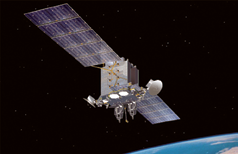
These four nations will use the Lockheed Martin-produced [NYSE: LMT] satellites for their most important transmissions, from commanders-in-chief to troops in the field.
The U.K. connection follows Canada’s first successful call in May, 2013, and The Netherlands’ initial connection came two months later. Over the past year AEHF facilitated many connections between international users, and U.S.-led tests in April included all four partners.
“AEHF is a keystone in global security. It is the only system that can provide highly-protected communications, circumventing our adversaries’ jammers in most wartime operations,” said Mark Calassa, vice president of Protected Communication Systems at Lockheed Martin.
“We are committed to driving this capability forward. All four partners are connected, and we are marching steadily toward Multi-Service Operational Test and Evaluation.”
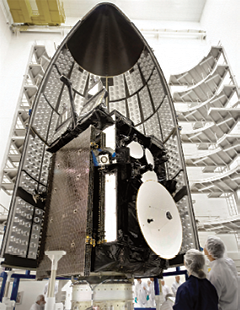
AEHF, from the inside out. Photo courtesy of Lockheed Martin.
U.K. armed forces started to connect over the course of several weeks beginning February 25.
They used two terminal variants to communicate with AEHF-2: One made for connections on land and another designed for users at sea.
Service members contacted the satellite at Colerne Airfield, Wiltshire, with the shore variant of the Navy Multiband Terminal (NMT).
In separate tests, U.K. users connected via the NMT ship variant from Telemetry & Command Station Oakhanger, Hampshire.
“AEHF not only delivers higher-bandwidth communications for the U.K., it makes communications with allies faster and easier,” Calassa said. “AEHF is showing it can handle the demands of protected coalition communications at high speeds, connecting nations with their own users and allied users across the globe.”
The four-nation AEHF program is led by the U.S. Air Force Space and Missile Systems Center at Los Angeles Air Force Base, California. Lockheed Martin is under contract to deliver the Mission Control Segment and six AEHF satellites, which are assembled at the company’s Sunnyvale, California, facility.
* * * * * * * * *
U.S. Army—Wanted... Rifleman Radios
The U.S. Army has released a draft Request for Proposals to procure additional Rifleman Radios using full and open competition.
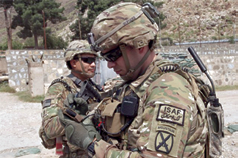
The draft Request for Proposal, which was posted May 21, 2014, to the Federal Business Opportunities website at http://www.fbo.gov/ moves the Army toward Full Rate Production for the Rifleman Radio, part of the Handheld, Manpack, Small Form Fit program.
Under the full and open competition approach, the Army will award contracts to multiple vendors, creating a “radio marketplace” where vendors will compete for delivery orders as needed, after they achieve technical and operational requirements.
“The full and open competition gives all vendors the opportunity to participate as we work together to build the Army network,” said Brig. Gen. Daniel P. Hughes, Program Executive Officer for Command, Control and Communications-Tactical. “The radio marketplace will support continuous innovation to deliver better radios for our Soldiers.”
The five-year base, plus a five-year option indefinite delivery, indefinite contract will be awarded to multiple vendors who meet both the technical and service requirements to support the radio.
This structure enables the Army to choose from numerous technologies, and release a new contract if radio technology changes significantly after the initial five-year award.
The competitive Non-Developmental Item acquisition strategy is expected to reduce radio procurement costs as the Army continues to modernize the network amid fiscal constraints.
The acquisition strategy also includes on-ramp opportunities for vendors whose technologies mature after the initial competition and operational tests.
A contract award is expected in fiscal year 2015.
Once the contract is awarded, each radio will undergo initial laboratory tests to determine if threshold requirements have been met.
Vendors that do not meet the qualifications will be off-ramped. Vendors that do meet the qualifications will move to the next phase, an operational test to be performed at one of the Army’s semi-annual Network Integration Evaluations.
The Rifleman Radio is a lightweight, rugged, hand-held radio that transmits voice and data via the Soldier Radio Waveform.
With the SRW, the Rifleman Radio acts as its own router and allows information to be transmitted up and down the chain, as well as into the network backbone provided by the Warfighter Information Network-Tactical.
The Rifleman Radio can also be linked to Nett Warrior, an Android-based, smartphone-like capability that enables Soldiers to send messages, access mission-related applications and track one another’s locations with Global Positioning System technology.
Through Low Rate Initial Production, the Army has already purchased 21,379 Rifleman Radios, which are carried by Soldiers at the platoon, squad and team levels.
The radios, fielded as part of the integrated Capability Set 13 network package, are currently supporting dismounted operations in support of the advise-and-assist mission in Afghanistan.
Fielding is now underway to additional brigade combat teams, as part of Capability Set 14, with eventual fielding planned across the entire force.
The Army’s total acquisition objective for the Rifleman Radio is 193,276 radios.
Story by Sgt. 1st Class E. L. Craig, Task Force Patriot PAO
* * * * * * * * *
NIMASA—To Catch A Hijacker
The Nigerian Maritime Administration and Safety Agency (NIMASA) has launched its satellite surveillance system, which, in conjunction with the Nigerian Navy and the Nigerian Air Force, successfully rescued Ghanaian Fishing Vessel Marine 711 from suspected hijackers on Thursday, June 5, 2014.
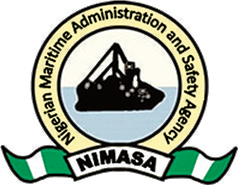
The Ghanaian registered vessel was reportedly hijacked off the coast of Ghana and sailed across Togo and Benin Republic to Nigerian waters when the Embassy of the Republic of Korea contacted the Agency to help rescue the vessel.
The Ghanaian Fisheries Authority and the Operators of the Fishing Vessel joined in requesting NIMASA to bring the incident to a logical conclusion.
In a swift operation coordinated by Capt. Warredi Enisuoh, NIMASA’s Director of Shipping Development, the Agency’s newly built satellite surveillance system with Cloud Penetrating Radar capabilities was brought to bear and the incident was resolved within six hours.
The NIMASA team, working with the Nigerian Navy and the Nigerian Air Force, which used air and sea patrols, quickly plotted a response and reception plan, which led to the hijackers abandoning their mission and fleeing.
The new 24-hour Surveillance Center has the capability to detect boats, ships and objects of predefined cross-section floating on water. This includes any aircraft that ditches and remains on the surface during satellite over-flight.
Its abilities further include, but are not limited to, setting range rings and restricted areas, which when penetrated by an intruder, activates an alarm, thereby alerting the operator.

The Director General of NIMASA, Ziakede Patrick Akpobolokemi, expressed satisfaction with the cooperation shown by all parties to the operation and noted that the Agency would continue to use cutting edge technology and partnership with the military to secure Nigerian waters for enhanced trade activities.
This is the first regional cooperation between NIMASA, Nigerian Navy, Nigerian Air Force and the Ghanaian Authorities in the anti-piracy war in the Gulf of Guinea, which hinges on the provisions of the Bilateral Agreement on Regional cooperation on anti-piracy in the Gulf of Guinea.
Nigeria, as signatory to the International Safety of Life and Sea (SOLAS) and Search and Rescue (SAR) Conventions, is obliged to intervene and provide co-ordination during Safety and Security-related incidents in her territorial waters and beyond.
The International Maritime Organisation (IMO) designated Nigeria as one of the five Regional Maritime Rescue Coordination Centers (RMRCCs) in Africa. Nigeria, therefore, provides SAR and Security Co-ordination in the waters of Benin Republic, Cameroon, Congo, Gabon, Sao Tome & Principe and Togo, in addition to its own territorial waters.
(Source: WorldStage News)




